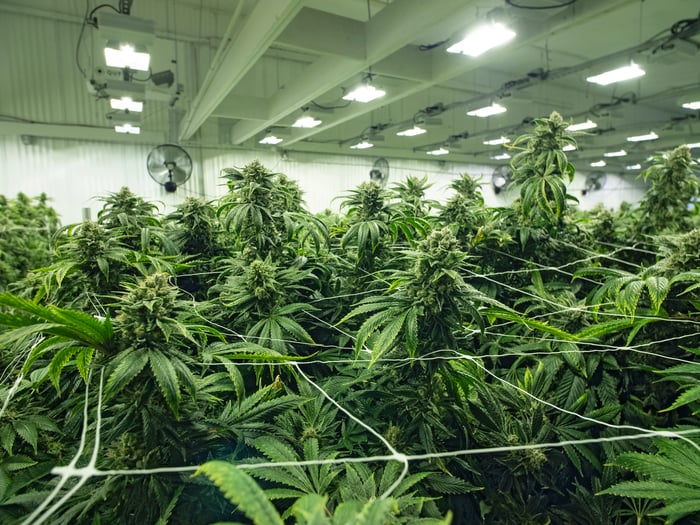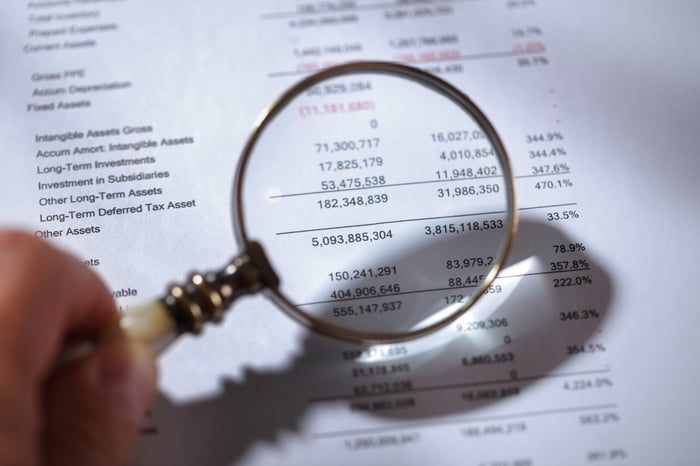Last year, the marijuana industry made history at practically every turn. We witnessed Canada become the first industrialized country in the world to legalize recreational cannabis, saw the U.S. Food and Drug Administration approve its very first cannabis-derived drug, and even had a pot stock go the initial public offering route on a major U.S. exchange.
But as the cannabis industry matures, Wall Street's means of evaluating the industry will be evolving, too. No longer are simple promises of "green pastures" enough to send marijuana stocks ascending to the heavens. With Canada having legalized adult-use weed, and 33 U.S. states having put medical marijuana laws on their books, earnings actually matter now. For some pot stocks, this hasn't been an issue, but for others, earnings time has equated to "duck-and-cover" for investors.

Image source: Getty Images.
One of Canada's largest but most under-the-radar pot producers just released its full-year earnings
On Monday, April 29, during the biggest week of earnings reports for S&P 500 companies in the second quarter, small-cap pot stock Aleafia Health (ALEAF 10.22%) dished on its fourth-quarter and full-year results from 2018, as well the company's outlook for 2019.
Aleafia, which completed its all-stock acquisition of Emblem in March, provided results separately, as well as on a pro forma basis, as if the two companies' results were combined on Dec. 31, 2018, when Aleafia's fourth quarter ended. On a pro forma basis, 2018 revenue rose 327% to 11.5 million Canadian dollars, with Aleafia contributing CA$3.3 million, of which CA$1.5 million was tied to consultation services at its clinics, CA$1.2 million came from research, and CA$0.6 million from the sale of cannabis.
As you might expect, expenses for the development of multiple grow facilities handily outpaced net revenue. Aleafia's net loss clocked in at CA$19.8 million in 2018 (not on a pro forma basis), with share-based compensation particularly increasing expenses, while Emblem's operating loss came in at CA$24.3 million.
Looking at the remainder of 2019, Aleafia foresees its outdoor Port Perry growing facility to be plant-ready this week, whereas its 160,000-square-foot indoor Niagara greenhouse should be fully complete by May 2019, although it's already in the plant-ready state. When combined with what Emblem brings to the table from an output standpoint, Aleafia expects to produce 138,000 kilos a year, which would make it Canada's No. 7 grower by peak production.
The company also recently announced its intention to build out processing capacity capable of extracting 50,000 kilos a year of cannabinoids. Construction should be complete by this coming June, with equipment in place by the midpoint of the third quarter.

Image source: Getty Images.
Three big questions Aleafia Health will need to answer
Clearly, it wasn't a great year given that Aleafia is late to the game in bringing its cannabis production on line. Then again, Aleafia appears to offer the best bang for investors' buck with 138,000 kilos of peak annual output and 50,000 kilos of yearly extraction capacity, all for a market cap of just $320 million. Of course, in order to prove its worth to Wall Street and investors, Aleafia Health has a couple of questions it's going to need to address.
1. Will Aleafia Health need more cash?
Arguably one of the biggest unknowns is whether the combined company, which had a pro forma cash balance of CA$63.2 million at the end of December, will need additional capital.
One of the bigger catalysts for the Emblem buyout, other than the fact that Emblem ran a similar business model that involves owning medical clinics and in-house cannabis supply, is that combining these two companies would bolster their cash position and allow for the presumably easier completion of the Port Perry and Niagara grow projects. However, after losing quite a bit of money in 2018, and with these projects still ongoing, expenditures are expected to be up notably in 2019.
Will CA$63 million prove to be enough of a buffer? My suspicion is that it won't be, with Aleafia Health probably turning to a bought-deal offering and selling shares of its common stock to raise capital at some point this year. With the understanding that share-based dilution is bad news for investors, this is something to keep in mind in the very near term.

Image source: Getty Images.
2. How will Emblem's supply agreement with Aphria impact margins?
Secondly, it's worth noting that Aleafia's acquisition of Emblem also meant absorbing Emblem's game-changing wholesale supply deal with Aphria (APHA).
In September 2018, Emblem signed a five-year agreement to purchase up to an aggregate of 175,000 kilos of dried cannabis flower and resin from Aphria, which would be processed at Emblem's Paris, Ontario, facility. With Aphria slated for perhaps 115,000 kilos of peak production by the end of 2019, and more like 255,000 kilos annually in each subsequent year, the deal it struck with Emblem represents perhaps 15% of its total five-year output.
Why make the deal? Prior to being acquired by Aleafia, Emblem was only on track for around 40,000 kilos of peak annual output, but needed a larger production presence to meet its aspiration of catering to a growing medical market and a burgeoning recreational community. By signing the wholesale supply agreement with Aphria, Emblem believed it had secured more than enough marijuana to turn its attention to building up its brands, marketing, and diversifying its product line.
What remains to be seen is if the newly combined Aleafia sees significant margin degradation by purchasing supply at wholesale prices and then selling this processed cannabis at market rates.

Image source: Getty Images.
3. Will the ends justify the means?
Lastly, Aleafia has to show Wall Street that its pie-in-the-sky production and extraction figures will actually translate into bottom-line results.
There's far more to a successful pot stock than production, and the newly formed Aleafia Health is going to need to demonstrate that it can control costs, brand its products effectively, move its products into overseas markets, and land significant domestic supply deals, if it's to move 138,000 kilos of cannabis, plus a minimum of 25,000 kilos of wholesale marijuana from Aphria, each year.
The reason Aleafia is getting zero respect from Wall Street right now is that there are zero assurances that the ends will justify the means. Once we begin to see tangible evidence of this happening, Aleafia's market cap could quickly catch up with other major Canadian producers.
In other words, it's "show-me" time for Aleafia Health.





